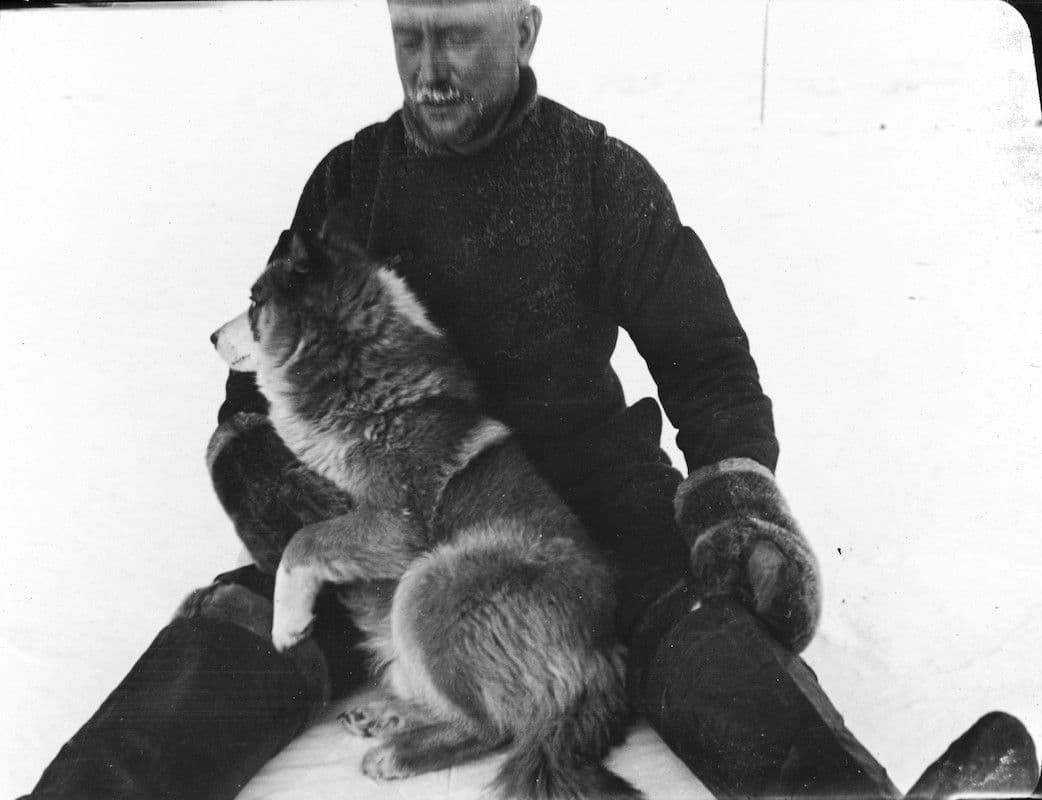More about Gloí in Greenland

24.07.2024Evelyn Ýr
Since I stumbled upon the story of Glói in Greenland in 1912/13, it hasn't let me go. I devoured the book after Vigfús Sigurðsson "Um þvert Grænland".
I still plan to make excerpts from this book and Alfred Wegener's diary to present Glói's story, but today I was lucky to receive an article about Glói written by Anna Louise Schneider. The article was previously published in Icelandshunden No. 1, 1999, the Danish club magazine. I got permission to publish a translation here on the website.
And here we go:
"I grabbed my cup with the dog meat and crawled down the mountain – or rather slid – as fast as I could, followed by Wegener.... During the slide down the mountain, I ate from my half-raw dog meat at every little stop. I had suddenly become terribly hungry, and the dog meat tasted like the most delightful dish to me." Thus ended the days of the Icelandic sheepdog GIöé, after having trekked 1200 km through ice and snow in -40 degrees, across northern Greenland, as a member of the Koch expedition of 1912-13."
In the book "Through the White Desert" by Captain J.P. Koch, the expedition is described in diary form. The purpose of the expedition was to investigate the natural conditions in the marginal zone of the inland ice, primarily atmospheric and geological conditions. The italicized passages are taken from this book.
Traditionally, sleds pulled by Greenlandic sled dogs have been used for expeditions to Greenland, but the conditions on the Koch expedition's planned route forced them to use other methods to progress.
They had to cross rough glacier ice, which the sleds could not withstand, and the dogs risked cutting their paws on the sharp and pointed ice needles. The journey also went through long stretches free of snow, where neither sleds nor dogs were suitable. The expedition also couldn't be sure they could move forward by boat due to ice formation. They had to carry all their goods overland to the edge of the ice. In summer, this could only be done using pack horses.
The expedition consisted of four men and 16 Icelandic horses.
One of the participants was the Icelandic leader Vigfus Sigurdsson, born in 1875; Vigfus was, as an Icelandic farmer, practically born and raised on a horse. As a postman in northern Iceland, he was particularly familiar with the arduous and often dangerous winter journeys over the snow-covered Icelandic highlands.
Vigfus naturally had an Icelandic sheepdog, Glói, with him on the expedition. Glói was also called the Kamik animal, and despite inquiries at the Arctic Institute in Copenhagen, there is no immediate explanation of whether the name has or had any special meaning (besides it being a term for shoes).
Besides helping Vigfus, Glói had other tasks, such as keeping foxes away from the house, scaring musk oxen away from the horses, and warning the people about polar bears.
The book contains many descriptions of how the dog was part of the expedition's daily life, and one clearly senses its character, which is very similar to the Icelandic sheepdog we know today.
October 21, 1912 Glói had so far had to stay outside, but when the temperature dropped to -28 degrees, he was exceptionally allowed to lie in the storage room. Here, where it was completely dark, he lay most of the day. He whimpered softly when stepped on, and one could hear him wag his tail when comforted. I felt there was no point in keeping a dog in such a way, so I brought him into the living room. Glói was happy. He licked our hands, gave his paw, rubbed his nose against our trousers, and trotted around until he, overwhelmed by the warmth, collapsed on the floor, from where Wegener lifted him onto his sofa.
One quickly gets used to an improvement in external conditions and therefore constantly seeks greater luxury. This was also the case with Glói. After resting on Wegener's sofa, he took a reconnaissance tour of the room and came across a low shelf under the table where food items – blood pudding, cheese, butter, and liver pate – were kept. The situation overwhelmed Glói. He just had to smell the liver pate. But by doing so, his nose got too close to a can, which fell to the floor. A few "whacks"! Out the door! - the bliss was over, and Glói lay again in the dark storage room, whimpering when stepped on. The next morning, I tried to bring him into the living room again, and this time it went well. Every time he got near the fatal liver pate, I gave him a warning: "Be careful, Glói! Ah, be careful!" And now he no longer touches the food shelf.... Since then, I look more kindly at Glói. The little story has brought us closer together.
The journey undertaken by the four men, their dog, and 16 horses was exciting but harsh.
They traveled by ship from Iceland towards Denmarkshavn in Greenland on July 7, 1912. By mid-October, they reached their wintering place, where they stayed until April the following year. Then began the long journey across Greenland, which ended on June 17. When they reached the colony "Prøven," all the horses were dead. Some were slaughtered along the way as they were no longer needed to transport the wintering house, thus extending the fodder for the remaining horses. About six horses died of exhaustion and hunger - the last horse, Grani, was attempted to be dragged on the sled, but they had to shoot it a few days before the goal was reached. Besides hay and concentrated feed, the horses were fed blood pudding, meat chocolate, horse meat, lemon drops, butter, cheese, and biscuits.
Glói proved to be incredibly resilient. When the horses sank to their bellies, Glói "swam" through the snow.
One night, the expedition's tent site was hit by a massive avalanche. All the men saved themselves, and the next morning they were reunited with Glói....
When we came out of the tent, Glói came running to meet us. We had missed him during the night and had heard him howling somewhere up the valley. It was likely that he was stuck in some crack. He had been lying behind the tent right where the ice blocks had crashed down; naturally, he had been frightened and had fled. We had searched for him during the night but could not find him, although he howled every time he was called. Now he had managed on his own.
At one point, however, Koch accuses Glói of being a bit dumber than a dog should be when crossing the inland ice. Today, we would probably find the situation comical and praise the dog for its problem-solving ability.
May 28, 1913, evening. It has been a cruel May month. I hope that June will be better. Poor Glói - he got into trouble. In the severe weather, we allowed him to be inside the tent, but he was always in the way and had difficulty managing under the difficult tent conditions. A few days ago, he failed to get out in time – it is not easy for him as the tent door is always closed – and as a result, he had to resort to Wegener's windbreaker hood. Naturally, he got a beating and was thrown out, and since then he has been more careful – too careful. Last night, when I lay by the tent door, he wanted to go out three times within the first four hours, so I constantly had to open and close the door for him. It affected my sleep. The third time, Glói was away for so long that I got tired of waiting for him, closed the tent door, and went to sleep. However, it was not the Kamik animal's intention to stay outside, and as he could not get in any other way, he gnawed a hole through the tent door. When Glói crawled over me, I woke up, and when I saw his misdeed, I gave him a good beating and threw him out again. Poor Kamik animal! It was -29 degrees last night and cold all day today. He no longer dares to ask to come into the tent but lies outside and freezes.
Glói survived the journey without illness or injuries, except for snow blindness, which everyone suffered from. When all the other animals had succumbed, Glói still followed. Near the goal, the men were very exhausted from hunger and cold. Glói lay on top of them to warm them.
First, we had to regain some strength, and for that, we had only one means: we had to slaughter our good friend, our little, kind dog.... It was hard to give the order, but I did it without hesitation. The situation was becoming critical.
The moment Koch was eating the half-raw dog meat, they could make contact with people suddenly appearing on boats in the fjord and were saved. The slaughter of Glói could thus have been avoided, but the men could not have foreseen that.
It is a somewhat sad ending to the story, but all Icelandic sheepdogs can be proud to "be related" to such a brave and clever travel companion.
In the book "Through the White Desert," there are many both touching and hair-raising descriptions of Glói and his people's journey across Greenland. If you are interested in Icelandic horses, it is definitely also exciting reading!
Literature: "The White Desert" by J.P. Koch. Gyldendals forlag 1914.
If you want to read more, "The Greenland Explorer Wegener - and the Drifting Continents," by Mogens Rud, is recommended - the book also mentions Glói Eilers forlag 1997.
The Arctic Institute has a library with additional literature on the subject. Tel. 32BB 0150.
Anna Louise Schneider
Contact
Lýtingsstaðir, 561 Varmahlíð.
+354 893 3817
[email protected]


